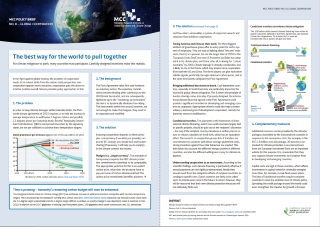The best way for the world to pull together
In the fight against global heating, the problem of cooperation needs to be solved: while from the nation-state perspective, non-cooperation appears more attractive, cooperation puts the actors in a better position overall. Science provides policy approaches to this.
1. The problem
In order to keep climate damages within tolerable limits, the Paris world climate agreement of 2015 requires us to hold the increase in average temperature to well below 2 degrees Celsius and possibly 1.5 degrees above pre-industrial levels. But the "Nationally Determined Contributions" (NDCs) announced since then by the signatory states are not yet sufficient to achieve these temperature targets.
2. The background
The Paris Agreement relies first and foremost on voluntary action. The voluntary commitments become binding after submission to the UN Climate Secretariat, and are subsequently tightened up in the "ratcheting-up mechanism", the aim is to dynamically eliminate free riding. The instruments within the accord, however, are not enough to make that happen: they need to be expanded and modified.
3. The solution
Enduring cooperation depends on three principles: transparency (I see what you provide), reciprocity (if I commit, you should too) and burden-sharing (if necessary, I will help you to comply). In the climate context, this means:
Pledges in a „single currency“. The principle of transparency requires the NDC climate protection commitments submitted to be comparable. The appropriate yardstick for this is an explicit carbon price: what does the producer have to pay per tonne of carbon dioxide emitted? The carbon price immediately identifies pioneers and free-riders, and enables a system of reciprocal rewards and sanctions that stabilises cooperation.
Taking America and China at their word. The three biggest emitters of greenhouse gases offer an entry point for such a system of reciprocity. They are now all talking about "net zero" emissions: the EU, as a pioneer, has set the target date of 2050 in the "European Green Deal", the new US President Joe Biden has adopted it in his climate plan, and China, after all, is aiming for “carbon neutrality” by 2060. Climate damage is already considerable, and is likely to rise in the future, which may inspire more cooperation from both the US and China. The three players can give each other reliable signals, preferably through minimum carbon prices, and at the same time jointly safeguard the Paris Agreement.
Bringing additional key states on board. Coal-dependent countries, especially in South East Asia, are particularly important for successful global climate mitigation. This is where the principle of burden-sharing comes into play: if properly designed, the international climate financing agreed in the Paris Agreement could provide a significant incentive for developing and emerging countries to cooperate. Appropriate reforms could also help to better achieve a declared goal of development cooperation, namely the domestic resource mobilisation.
Conditional transfers. The payments in the framework of international climate financing, which have until now been largely tied to specific projects, should be paid out at the recipient's discretion – but only if the recipient country introduces a carbon price in return or reduces subsidies on fossil fuels, which has an equivalent effect. The research on cooperation proves this: if transfers are concentrated on countries with above-average abatement costs, strong incentives against free-rider behaviour are created. This then takes into account the different energy systems in different countries, and also the different willingness to pay for climate mitigation.
Understanding cooperation as an investment. According to the scientific findings, such climate financing is particularly effective if annual payments are not rigidly predetermined. Ideally they should result from the mitigation efforts of recipient countries, according to specific rules. Donor countries are likely to be called upon to provide even more in the future. In return, however, they will be reassured that their own climate protection measures will not ultimately fizzle out.
4. Complementary measures
If the EU should indeed secure its carbon pricing with a pragmatic border adjustment in order to counteract the mere relocation of emissions, an important choice must be made – how to make use of revenues. Economic analyses show that when industrialised countries retain them for themselves, this shifts the burden of the climate policy package towards developing countries, rather than other industrialised countries.
Revenues from the border carbon adjustment should therefore be earmarked for technology transfer and international climate financing (Green Climate Fund). Other solutions could also be negotiated: trading partners might carry out border adjustment themselves, using tax revenues from exports to the EU to invest in climate protection.






